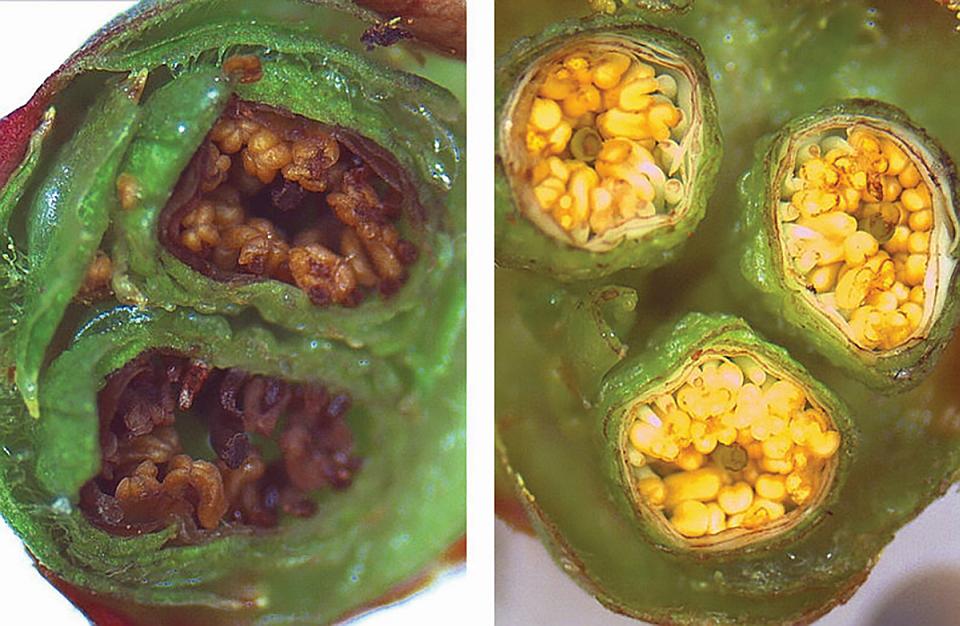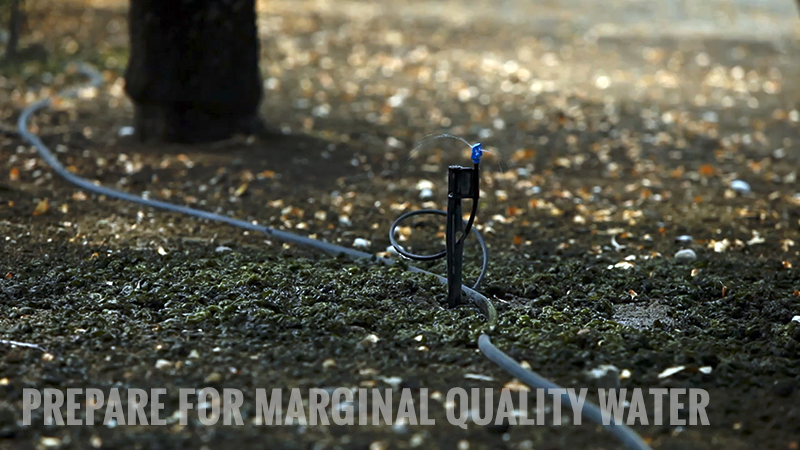Forest Industry Byproduct has Big Potential for Frost Control

The damage to cherry buds from frost is evident by the darkened tissue of the buds on the left as compared to the healthy buds on the right. (Photo: Washington State University)
Frost damage is always a challenge with tree fruit and vines. One cold snap can ruin a future season in a matter of minutes. But, Matthew Whiting, Professor of Horticulture at Washington State University’s Irrigated Agriculture Research and Extension Center in Prosser, WA, notes the options for frost control have been the same for many years.
“Out West , growers have utilized the same systems for decades,” he says. “They’ve been combining wind machines with under-tree microsprinklers and sometimes heaters.”
But innovation has a funny way of finding its way into the fruit industry. Which is why a meeting at WSU’s Center for Precision & Automated Agricultural Systems (CPAAS) has turned into something with great potential for the future of frost protection in fruits.
“I’m in horticulture. I wouldn’t have known about these other things,” he says. “You can make some of these connections that wouldn’t have been made otherwise,” he says.
One such connection has been forged with cellulose nanocrystals — a byproduct of the forestry industry. During a meeting with Xiao Zhang, Associate Professor of Voiland School of Chemical Engineering and Bioengineering and WSU Tri-Cities’ Bioproducts Science Engineering Laboratory, the idea of applying cellulose nanocrystal for frost protection came up.
“They have extraordinarily good insulating properties,” Whiting says of cellulose nanocrystals. “As I learned more about the thermal properties, I became intrigued at the possibility of utilizing those for frost protection.”
Early Trials
Zhang, worked with cellulose nanocrystals and formulated a spray suspension. Two years ago, members of CPAAS including Zhang, Whiting, Changki Mo, Associate Professor of Mechanical Engineering, and Qin Zhang, Professor of Biosystems Engineering, formed a team to investigate the application of cellulose nanocrystals for tree fruit frost protection.
The team conducted a field trial in spring 2018. Whiting collected untreated and treated buds and put them into a programable freeze chamber used for other cold-hardiness evaluations to simulate a damaging freeze.
“We found a considerable benefit to the applications of the cellulose nanocrystals,” Whiting says. “That piqued our interest, of course.”
Buoyed by the success of the initial trial, the team secured USDA-National Institute for Food and Agriculture funding and a grant from the Washington Tree Fruit Research Commission to fine-tune applications of cellulose nanocrystals and learn more about how they provide protection.
“I guess it was kind of an indicator that it was time for something new in terms of reducing cold damage,” Whiting says.
Further Research
This year, the team expanded their research to sweet cherries and apples. Whiting says the preliminary data from this year show a similar effect on tree fruits as it did on last year’s grape buds. And Whiting says this material had a broad application to all fruits threatened by spring freezes.
“We think is one of the very compelling aspects of this is that it’s not going to be species- or crop-specific,” he says.
Currently, Whiting says while the team understands the material works, the research will focus on rates, frequency, and application.
“We’ve got some very simple questions: What rate should we use? How much of the nanocrystals is of benefit, and what is the optimum? Is the higher concentration just better? We don’t know,” he says. “There are application technologies, there are rates, there are timings. We’re interested to find out more about when, how often a grower may need to reapply the material if they went out in the middle of the week and coated the tree.”
And, Whiting says, how the material is applied also needs to be determined.
“There’s also a practical aspect to application technology we’re going to look at. We feel that it may be important to use electrostatic application systems to get a good covering of the material over flowers and or buds to provide that protectant,” he says. “That needs to be determined as well.”
The team is also interested in learning how the material protects the buds from cold damage. And interest isn’t coming just from his research colleagues, but from growers, too. Whiting says once some of the questions on application methods and rates are determined, this technology will move to testing in commercial orchards.
“We want to look at some concentration studies to find that cost/benefit assessment,” he says. “And then we’re absolutely going to use larger-scale trials in commercial blocks.”
Fortuitous Forestry Find
Cellulose nanocrystals are an intriguing byproduct from the pulp and paper industry. Whiting says cellulose is the most abundant polymer on Earth and makes up close to 50% of the dry matter of plant materials.
Whiting says given its availability, cellulose nanocrystals have the potential of a viable solution for a long time.
“This is a new tool, and we found that it’s considerably more effective than current strategies,” he says. “We can plant trees and make more of it. It’s really sustainable and, we think, a green and a longer-term solution.”
A patent has been filed for this application of cellulose nanocrystals.










